Smarter Trading
| Автор(ы): | Kaufman Perry J.
06.10.2007
|
| Год изд.: | 1995 |
| Описание: | Вот наш лит. перевод аннотации: "В результате экономической глобализации и компьютеризации рынок, который мы имеем - это полный бардак, в результате которого мы с одинаковой легкостью можем как продвинуться в своей карьере трейдера, так и оказаться в глубокой {sencored}. В этой выдающейся книге (ведь если мы не напишем "выдающейся" - никто её не купит) автор помагает профессиональным спекулянтам не повредиться крышей несмотря на вышеозначенный бардак посредством создания трезвой легкоприспосабливаемой к изменяющимся условиям модели. В общем, крыша всё равно отъезжает, но уже не от хаоса рынка, а от всяких там высокотехнологичных (HI-TECH, значицца, привет вам, ребята) торговых технологий: нейронные сети, нечеткая логика, стохастическая математика, фракталы и фрактологи etc". |
| Оглавление: |
 Обложка книги.
Обложка книги.
1. The Impact of Change on Markets and Trading [3] Changing Factors Affecting Markets and Prices [3] Technical Analysis [7] Evolution and Obsolescence [12] Structural Change: Seasonality [15] The Evolution of Markets [17] 2. Assessing Market Reality [19] The Screen Is History [19] Execution Problems and Performance [22] Globalization: Simultaneous Absorption [26] Factors That Always Exist [27] Change and Evolution [28] 3. Reasonable Expectations Give Achievable Results [31] Trade-Offs [31] Giving the Computer Free Reign [33] Throwing Microchips at It [35] The Use of Systems [38] Expectations [40] 4. Risk and Return [41] Risk Preference [41] Standardizing Risk and Return [42] Choosing between the Currency and Bond Portfolios [46] Time Periods Tell Different Stories [48] Specifying Acceptable Risk [50] Graphing Risk and Reward [51] Diversification and Risk Reduction [53] Adding Common Sense to Statistics [61] Risk of Ruin [66] Profit Goals [66] Summary [68] Part 2. Using Old and New Trading Tools to Achieve Reasonable Objectives 5. Profit-Taking [73] A Test for Profit-Taking [74] The Results [77] Profit Objectives versus Time [81] Benefits of Using More Than One Profit Objective [83] Summary [88] 6. The Mixed Role of Stops for Controlling Risk [89] Need for Risk Control [90] Risk Protection or False Hope? [90] Testing a System with a Stop-Loss [94] A Stop-Loss May Conflict with the Strategy [103] Managing Risk with and without Stops [104] Summary [105] 7. Understanding Price Shocks [1O7] Trading Risk Is Higher Than Expectations [107] Types of Price Shocks [109] Impact of a Price Shock on an Investment [110] Handling Price Shocks [118] Managing a Price Shock [120] Summary [127] 8. Smarter Trend-Following [129] Forecasting and Following [129] Trend Trading [131] Adaptive Approach [133] The Adaptive Moving Average [138] Trading Rules [143] Testing the AMA [146] Programming the Adaptive Moving Average [147] 9. Computer Learning, Neural Networks, and New Technology [155] The Teaching Process: First the Trainer [156] Artificial Intelligence and Pattern Recognition [157] Applications of Expert Systems [160] Neural Networks [164] Fuzzy Logic [171] Part 3. Making a Trading Strategy Robust 10. Testing for Robustness [177] Overfitting [177] Separating Robustness from Parameter Selection [178] Testing Process [181] Part 1: Deciding What to Test [182] Part 2: Deciding How to Test [186] Part 3: Evaluating the Results [204] Part 4: Choosing the Specific Parameters to Trade [209] Part 5: Trading and Monitoring Performance [212] Other Important Practical Guidelines [213] Summary [217] 11. Improving the Performance of Existing Systems [219] Measuring and Monitoring Predictability [219] Anticipation [223] Filtering System Signals [227] Reversing the Optimization Concept [235] Overnight Risk [236] Leverage, Costs, and Trend Speed [238] Appendix: Notation and Terminology [214] Index [245] |
| Формат: | djvu |
| Размер: | 5186845 байт |
| Язык: | ENG |
| Рейтинг: |
355
|
| Открыть: | Ссылка (RU) |